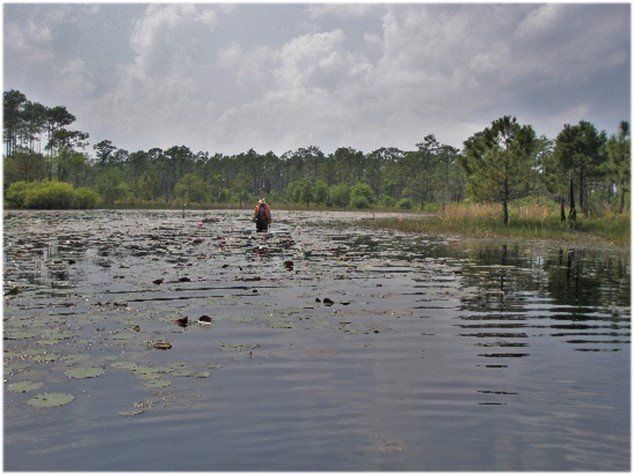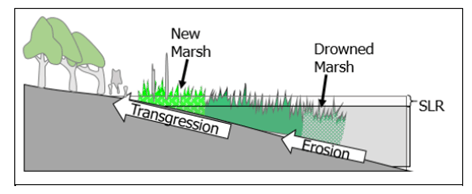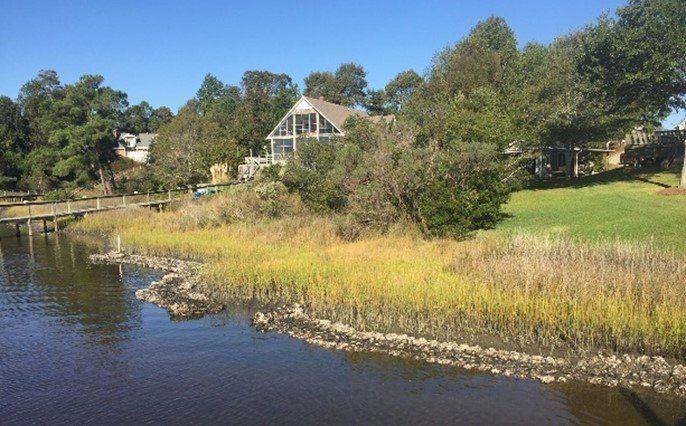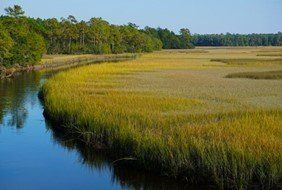Wetlands and Climate Change
Abstract
Climate change is the rise in average surface temperatures on Earth, mostly due to the burning of fossil fuels. Climate change is causing intensifying storm activity, rising sea levels and creating more frequent floods and droughts in the Carolinas and worldwide. Recent, significant storm events in North and South Carolina include Hurricane Florence (2018), Hurricane Matthew (2016) and Hurricane Floyd (1999).

Aerial view of Hurricane Florence (2018) heading for the Carolinas. Photo: NASA
Abstract
Climate change is the rise in average surface temperatures on Earth, mostly due to the burning of fossil fuels. Climate change is causing intensifying storm activity, rising sea levels and creating more frequent floods and droughts in the Carolinas and worldwide. Recent, significant storm events in North and South Carolina include Hurricane Florence (2018), Hurricane Matthew (2016) and Hurricane Floyd (1999).

Aerial view of Hurricane Florence (2018) heading for the Carolinas. Photo: NASA
Increased storm activity is having a huge economic and environmental impact on our coastal and inland communities in the Carolinas. Hurricane Matthew caused an estimated $4.8 billion in damages. Hurricane Floyd caused between $7 and $9.4 billion, and the damage from Hurricane Florence was estimated to be nearly $17 billion – more than Matthew and Floyd combined.
Wetlands play a critical role to help mitigate increased storm activity caused by climate change by retaining floodwater, stormwater and storm surges. Because of their critical importance during these storm events, wetland protection and conservation is essential to combating the effects of climate change in the Carolinas.
Webinar: May 2022
Problem Statement
Climate change is here. As defined by NASA, climate change refers to long-term changes in the average weather patterns that have come to define Earth’s local, regional and global climate1. Climate change causes increased temperatures and storm activity, contributes to rising sea levels, elevates storm surges and causes more frequent flooding. The economic impact of recent, intense storm activity in the Carolinas has been devastating over the last 10 years. In 2018, Hurricane Florence produced a record storm surge of 9 to 13 feet and caused catastrophic flooding inland for days2. More than 50 people died across the region; 42 in North Carolina alone. North Carolina’s Governor Roy Cooper estimated Florence’s damage in North Carolina at $17 billion—an amount more than Hurricane Matthew and the previous historic hurricane, Floyd in 1999, combined2.
Flooding not only causes property damage, but also impacts public health and overall well-being in our communities3. Flooding can destroy a home, leaving it uninhabitable. There are also numerous hidden dangers in flood waters that create a public health risk: live wires, broken glass, and sharp metal as well as bacteria and other pathogens4.
Background
There is general agreement amongst the scientific community that climate change is real. Also referred to as global warming, climate change is causing a rise in average surface temperatures on around the globe1. 2019 was the warmest year on record in North Carolina.In the Carolinas, scientists have observed an increase in annual average temperature by 1.0o F since 1895. In North Carolina, the last 10 years (2009 – 2018) represented the warmest 10-year period on record5. In Charleston, South Carolina, 2019 was the fourth-warmest year on record, which ended the warmest decade to date6.
In addition to rising temperatures, climate change is intensifying storm activity, rising sea levels and causing more frequent floods and droughts worldwide. The Carolinas have experienced several major hurricanes in the last 5 years, including Hurricane Matthew (2016), Florence (2018) and Dorian (2019). These hurricanes caused widespread flooding in dozens of coastal communities, resulting in billions of dollars in property damage.
Extreme flooding events occurred during hurricanes Matthew (2016) and Florence (2018) in North and South Carolina5. Florence was a historic storm, breaking 28 flood records across North and South Carolina7. Some of the flooding records are over 75 years old, including the Northeast Cape Fear River near Chinaquapin, NC (78 years) and the Little Pee Dee River at Galivants Ferry, SC (77 years).
Solution
Wetlands play an absolutely critical role in mitigating the impacts of climate change, by retaining floodwater, stormwater and storm surges. Wetlands also store, or sequester, excess carbon in the atmosphere through photosynthesis8. Carbon dioxide in the atmosphere is absorbed by wetland plants during photosynthesis and is retained in the plants’ biomass (roots, shoots, tree bark and leaves) and in the soil as soil organic matter.

View of Lily Pond in May of 2015 within the Croatan National Forest in North Carolina. This wetland is well known for its capacity to retain water after storm events, slowly releasing the water back into the environment. Photo: Kristie Gianopulos
When an area floods with water, surrounding wetlands act like a giant sponge; living plants and even the dead plant matter along with porous soils can absorb the extra water. Wetlands also help slow down the movement of floodwater to surrounding areas – which would otherwise impact homes and businesses. In coastal areas, marsh wetlands protect shorelines from erosion by buffering wave action and trapping sediments. They reduce flooding by slowing and absorbing rainwater and protect water quality by filtering runoff. Coastal marshes can also migrate landward (Figure 1). Trapped sediments allow the marshes to rise in elevation, which helps mitigate the effects of sea level rise (SLR).
Because of their ability to mitigate sea level rise, absorb rainwater, retain floodwater and store atmospheric carbon dioxide, wetland protection and conservation is essential in the Carolinas.

Figure 1. Landward migration of salt marsh with sea level rise (SRL). (Figure courtesy of DCERP 2 Final Report, 2018.)9
Wetlands can be protected and conserved in a number of ways:
- By not developing or impacting wetlands (e.g., filling, ditching, placing wetlands under protective easement),
- If you live on waterfront property, wetlands can be protected by installing a “living shoreline” (see photo – left) – a mix of plant roots, sand and stone instead of man-made structures, like retaining walls, to stabilize the soil.

View of a living shoreline along the Carolina coast. Photo: Restoration Systems
Abstract
Climate change is the rise in average surface temperatures on Earth, mostly due to the burning of fossil fuels. Climate change is causing intensifying storm activity, rising sea levels and creating more frequent floods and droughts in the Carolinas and worldwide. Recent, significant storm events in North and South Carolina include Hurricane Florence (2018), Hurricane Matthew (2016) and Hurricane Floyd (1999).

Aerial view of Hurricane Florence (2018) heading for the Carolinas. Photo: NASA
Abstract
Climate change is the rise in average surface temperatures on Earth, mostly due to the burning of fossil fuels. Climate change is causing intensifying storm activity, rising sea levels and creating more frequent floods and droughts in the Carolinas and worldwide. Recent, significant storm events in North and South Carolina include Hurricane Florence (2018), Hurricane Matthew (2016) and Hurricane Floyd (1999).

Aerial view of Hurricane Florence (2018) heading for the Carolinas. Photo: NASA
Increased storm activity is having a huge economic and environmental impact on our coastal and inland communities in the Carolinas. Hurricane Matthew caused an estimated $4.8 billion in damages. Hurricane Floyd caused between $7 and $9.4 billion, and the damage from Hurricane Florence was estimated to be nearly $17 billion – more than Matthew and Floyd combined.
Wetlands play a critical role to help mitigate increased storm activity caused by climate change by retaining floodwater, stormwater and storm surges. Because of their critical importance during these storm events, wetland protection and conservation is essential to combating the effects of climate change in the Carolinas.
Webinar: May 2022
Problem Statement
Climate change is here. As defined by NASA, climate change refers to long-term changes in the average weather patterns that have come to define Earth’s local, regional and global climate1. Climate change causes increased temperatures and storm activity, contributes to rising sea levels, elevates storm surges and causes more frequent flooding. The economic impact of recent, intense storm activity in the Carolinas has been devastating over the last 10 years. In 2018, Hurricane Florence produced a record storm surge of 9 to 13 feet and caused catastrophic flooding inland for days(2). More than 50 people died across the region; 42 in North Carolina alone. North Carolina’s Governor Roy Cooper estimated Florence’s damage in North Carolina at $17 billion—an amount more than Hurricane Matthew and the previous historic hurricane, Floyd in 1999, combined(2).
Flooding not only causes property damage, but also impacts public health and overall well-being in our communities(3). Flooding can destroy a home, leaving it uninhabitable. There are also numerous hidden dangers in flood waters that create a public health risk: live wires, broken glass, and sharp metal as well as bacteria and other pathogens(4).
Background
There is general agreement amongst the scientific community that climate change is real. Also referred to as global warming, climate change is causing a rise in average surface temperatures on around the globe1. 2019 was the warmest year on record in North Carolina. In the Carolinas, scientists have observed an increase in annual average temperature by 1.0o F since 1895. In North Carolina, the last 10 years (2009 – 2018) represented the warmest 10-year period on record(5). In Charleston, South Carolina, 2019 was the fourth-warmest year on record, which ended the warmest decade to date(6).
In addition to rising temperatures, climate change is intensifying storm activity, rising sea levels and causing more frequent floods and droughts worldwide. The Carolinas have experienced several major hurricanes in the last 5 years, including Hurricane Matthew (2016), Florence (2018) and Dorian (2019). These hurricanes caused widespread flooding in dozens of coastal communities, resulting in billions of dollars in property damage.
Extreme flooding events occurred during hurricanes Matthew (2016) and Florence (2018) in North and South Carolina(5). Florence was a historic storm, breaking 28 flood records across North and South Carolina(7). Some of the flooding records are over 75 years old, including the Northeast Cape Fear River near Chinaquapin, NC (78 years) and the Little Pee Dee River at Galivants Ferry, SC (77 years).
Solution
Wetlands play an absolutely critical role in mitigating the impacts of climate change, by retaining floodwater, stormwater and storm surges. Wetlands also store, or sequester, excess carbon in the atmosphere through photosynthesis(8). Carbon dioxide in the atmosphere is absorbed by wetland plants during photosynthesis and is retained in the plants’ biomass (roots, shoots, tree bark and leaves) and in the soil as soil organic matter.

View of Lily Pond in May of 2015 within the Croatan National Forest in North Carolina. This wetland is well known for its capacity to retain water after storm events, slowly releasing the water back into the environment. Photo: Kristie Gianopulos
When an area floods with water, surrounding wetlands act like a giant sponge; living plants and even the dead plant matter along with porous soils can absorb the extra water. Wetlands also help slow down the movement of floodwater to surrounding areas – which would otherwise impact homes and businesses. In coastal areas, marsh wetlands protect shorelines from erosion by buffering wave action and trapping sediments. They reduce flooding by slowing and absorbing rainwater and protect water quality by filtering runoff. Coastal marshes can also migrate landward (Figure 1). Trapped sediments allow the marshes to rise in elevation, which helps mitigate the effects of sea level rise (SLR).
Because of their ability to mitigate sea level rise, absorb rainwater, retain floodwater and store atmospheric carbon dioxide, wetland protection and conservation is essential in the Carolinas.

Figure 1. Landward migration of salt marsh with sea level rise (SRL). (Figure courtesy of DCERP 2 Final Report, 2018.)9
Wetlands can be protected and conserved in a number of ways:
- By not developing or impacting wetlands (e.g., filling, ditching, placing wetlands under protective easement),
- If you live on waterfront property, wetlands can be protected by installing a “living shoreline” (see photo – left) – a mix of plant roots, sand and stone instead of man-made structures, like retaining walls, to stabilize the soil.

View of a living shoreline along the Carolina coast. Photo: Restoration Systems
Conclusion
Climate change isn’t going away. Climate change intensifies storm activity, and scientists predict an increase in tropical storm frequencies from 1-10% in coming years10. Wetlands play a critical role to help offset the impacts of climate change by retaining floodwater, stormwater and storm surge. Wetlands also hold tremendous value as a climate change mitigator through their ability to sequester carbon within the organic content in the soil.
The impacts of climate change on local communities can be significantly lessened by protecting local wetlands. The can be done by:
- Avoiding the development or impact of wetlands (e.g., filling, ditching);
- Avoiding wetlands if planning a home, building, shed or farm field expansion; and
- By placing wetlands under protective easement (e.g., conservation easement).
- Wetlands can be protected by installing a “living shoreline” (see photo) to stabilize the soil – a mix of plant roots, sand and stone instead of man-made structures, like retaining walls.

View of a saltwater marsh in Francis Marion National Forest. Photo: Kristie Gianopolus
Conclusion
Climate change isn’t going away. Climate change intensifies storm activity, and scientists predict an increase in tropical storm frequencies from 1-10% in coming years10. Wetlands play a critical role to help offset the impacts of climate change by retaining floodwater, stormwater and storm surge. Wetlands also hold tremendous value as a climate change mitigator through their ability to sequester carbon within the organic content in the soil.
The impacts of climate change on local communities can be significantly lessened by protecting local wetlands. The can be done by:
- Avoiding the development or impact of wetlands (e.g., filling, ditching);
- Avoiding wetlands if planning a home, building, shed or farm field expansion; and
- By placing wetlands under protective easement (e.g., conservation easement).
- Wetlands can be protected by installing a “living shoreline” (see photo) to stabilize the soil – a mix of plant roots, sand and stone instead of man-made structures, like retaining walls.

View of a saltwater marsh in Francis Marion National Forest. Photo: Kristie Gianopolus
There are a number of existing wetland protection programs in place in the Carolinas, and these programs greatly benefit from volunteer contributions and involvement:
- North Carolina Department of Environmental Quality’s Division of Mitigation Services
- North Carolina Coastal Land Trust
- South Carolina’s Department of Health and Environmental Control
- North Carolina Coastal Federation
References
- NASA’s Climate Center “Overview: Weather, Global Warming and Climate Change” [Online]. Available: https://climate.nasa.gov/resources/global-warming-vs-climate-change/ [Accessed July 1, 2020].
- Economic impact of Florence: https://insideclimatenews.org/news/27122018/hurricane-damage-north-carolina-climate-change-2018-year-review-florence-michael-matthew#:~:text=Hurricane%20Florence%20produced%20a%20record,Carolina%20alone%20at%20%2417%20billion.
- Economic impact: https://www.newsobserver.com/news/technology/article215476785.html
- Health Impacts of Flooding: https://edmdigest.com/resources/florence-flooding/
- Kunkel, K.E., R. Easterling, A. Ballinger, S. Biligin, S.M. Champion, D.R. Corbett, K.D. Dello, J. Dissen, J.M. Lackmann, R.A. Lutteich, Jr., L.B. Perry, W.A. Robinson, L.E. Stevens, B.C. Stewart, and A.J. Terando, 2020: North Carolina Climate Science Report. North Carolina Institute for Climate Studies, 233 pp. https://ncics.org/wp-content/uploads/2020/06/NC_Climate_Science_Report_FullReport_Final_revised_May2020.pdf
- https://abcnews4.com/news/local/noaa-2019-was-the-2nd-hottest-year-on-record
- https://www.newsobserver.com/news/local/article222615945.html
- Association of State Wetland Managers: “Carbon Sequestration” [online] www.aswm.org.
- DCERP (2018). Defense Coastal/Estuarine Research Program 2 Final Report. Retrieved from https://dcerp.serdp-estcp.org/Portals/0/FinalReports/RC2245_DCERP2_Final_Report.pdf
- https://www.gfdl.noaa.gov/global-warming-and-hurricanes/
- Michener, W.K., E.R. Blood, K.L. Bildstein, M.M. Brinson and L.R. Gardner. Climate Change, Hurricanes and Tropical Storms, and Rising Seal Level in Coastal Wetlands. 1997. Ecological Applications, Vol. 7, No. 3, pp. 770-801.
- C. Kozak, “Restoration Work – A Test for Carbon Farming,” Coastal Review Online, 01-Aug-2019. [Online]. Available: https://www.coastalreview.org/2019/01/restoration-work-a-test-for-carbon-farming/. [Accessed: 11-Feb-2020].
Written by:

Heather Patti, PWS is a Senior Ecologist and Project Manager at TRC Companies, specializing in wetland and stream delineation, permitting and endangered species assessments for the renewable energy industry. Heather is a proud mother of 2 boys, Ben and Wyatt, and in her free time enjoys hiking, camping, botanizing and kayaking. She is a terrible fisherman.
Mailing Address
Carolina Wetlands Association
PO Box 3359
Raleigh, NC 27636
Mailing Address
Carolina Wetlands Association
PO Box 3359
Raleigh, NC 27636
Mailing Address
Carolina Wetlands Association
PO Box 3359
2Raleigh, NC 27636
All Rights Reserved | Carolina Wetlands Association

